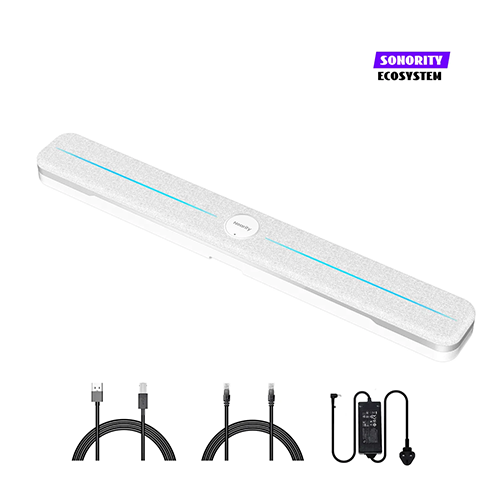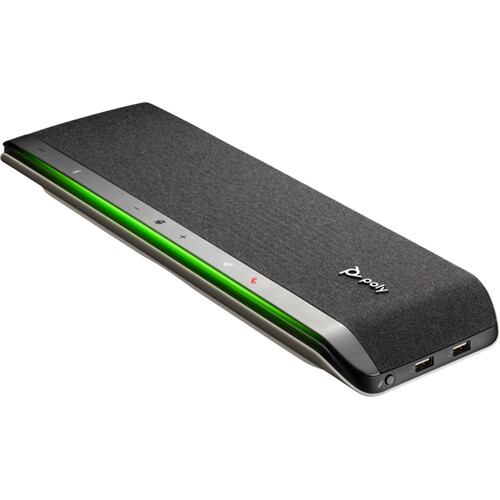An essential resource for IT managers and AV integrators, this 2025 guide demystifies modern conference room microphone solutions by tracing their technological evolution, outlining four key mic form factors, and providing a practical framework for choosing and deploying the right system. With expert product recommendations and real‑world setup tips, readers will gain the insights needed to elevate hybrid meeting audio quality and foster seamless collaboration.
Ever sat through a high‑stakes meeting only to realize half your team (especially the remote folks) can’t hear a word? Straining to catch every third word, dealing with echo, or cranking up volume so high your ears ring afterward—these are all too real frustrations. In 2025, an effective conference room mic setup isn’t a “nice‑to‑have”—it’s mission‑critical for productivity, engagement, and collaboration. Whether you’re outfitting a small huddle room or a multi‑zone boardroom, this guide will walk you through everything from the history of these systems to hands‑on product recommendations. Let’s dive in!
The Evolution of Conference Mic System
Conference microphones began as simple single‑element units placed in the center of a meeting table, forcing participants to lean in and pass a “hot mic” around to be heard. By the late 1960s and early 70s, automatic mixers—first patented by Bell Labs in 1969—could switch audio to the loudest speaker, reducing background noise and simplifying multi‑mic setups. Through the 1980s and 1990s, manufacturers like Shure and Altec refined automixers and boundary mics, improving clarity in theater and boardroom applications. In the 2000s, digital signal processing (DSP) brought real‑time echo cancellation and noise suppression, laying the groundwork for today’s AI‑powered beamforming arrays and virtual microphone grids.
Today’s conference room mic system combines multiple MEMS mic elements, machine‑learning noise reduction, and IP‑based networking to deliver crystal‑clear pickup across large spaces—no matter where participants sit. Beamforming techniques dynamically steer “virtual” mic zones to track active speakers, while full‑duplex audio ensures natural, interruption‑free conversations. This blend of hardware and software marks a generational leap from passive single‑capsule mics to intelligent, self‑optimizing systems built for hybrid work.
The Types of Conference Room Mic
Choosing the right conference room mic starts with understanding the four core form factors — and how each fits different room sizes, décor, and use cases.
Wireless Conference Room Mic
Wireless mics free participants from cable clutter and fixed positions, using Wi‑Fi or DECT radios to transmit audio back to the sound system. A popular example is the Nearity A22 bluetooth conference speakerphone, featuring 8 Microphones arranged in a 360° array pick up voices from all directions and AI-powered technology. Ideal for training rooms, boardrooms with movable tables, or hybrid classrooms, wireless mic pods let speakers move and power‑point presenters roam without sacrificing clarity.
Ceiling Conference Room Mic
Ceiling mics use beamforming arrays mounted overhead, unobtrusively capturing sound from every corner. For instance, the Nearity A31S‑C embeds eight MEMS elements and AI‑driven virtual microphone grids in a slim housing, offering 3D spatial audio up to 8 m away and PoE for installation ease. Ceiling arrays eliminate desktop clutter and ensure consistent pickup—perfect for modern huddle spaces and executive boardrooms with glass walls or open ceilings.
Tabletop Conference Room Mic
Tabletop or desktop speakerphones integrate mics and speakers into a single device placed in the room’s center. The Nearity A21S, for example, offers 8 omnidirectional MEMS microphones and daisy‑chain capability for larger rooms. Tabletop mics are plug‑and‑play, affordable, and versatile—ideal for small to mid‑sized huddle rooms and personal offices.
Wall‑mounted Conference Room Mic
Wall‑mounted or boundary mics capture sound reflections off the surface, offering discrete placement for panel discussions or U‑shaped tables. They typically use cardioid or supercardioid capsules to focus on voices and reject room noise. While less common than ceiling or tabletop units, they fit specialized boardrooms or legislative chambers where wall‑mount points are available.
How to Choose the Right Conference Room Mics
Selecting the best mic for conference calls involves evaluating your room’s size, shape, seating layout, and meeting style. Follow these steps:
- Measure room dimensions and seating plan. For example, a 10 × 10 ft huddle room needs one tabletop mic; a 20 × 30 ft boardroom may require multiple ceiling arrays or daisy‑chained desktop units.
- Assess ambient noise sources. Does HVAC hum or open‐plan chatter interfere? Look for mics with AI noise suppression or directional pickup.
- Determine coverage zones. Use beamforming ceiling mics for full‑room coverage, or deploy multiple tabletop pods evenly spaced for uniform pickup.
- Consider installation and aesthetics. Ceiling mics hide in the grid; tabletop units are visible but portable; wall mics mount flush for minimal impact.
- Check connectivity and power. PoE simplifies ceiling installations; USB/Bluetooth suits BYOD desktop setups. Ensure compatibility with your video conferencing platform.
- Scale for future needs. Systems like the Nearity Sonority ecosystem let you add units and daisy‑chain for larger spaces without rewiring.
By mapping these factors against the four mic types, you’ll land on a tailored conference room mic system built for clear, reliable hybrid meetings.
Improve Collaboration with Recommended Conference Mics
Here are four top picks—each excels in different room types and budgets, but all deliver pro‑grade audio for 2025.
Nearity Sonority Audio Ecosystem A31S‑C with Multiple Mounting Options

A31S‑C is a ceiling array mic offering:
- 8‑MEMS microphone array with AI‑noise and echo cancellation.
- 3D Spatial Audio with virtual mic grid, stable pickup up to 8 m.
- Full‑duplex communication and feedback suppression.
- IP‑based audio mixing with PoE in/out for daisy‑chaining up to 8 units.
Flexible installation on ceiling, wall, or desktop makes it ideal for large boardrooms and multi‑zone collaboration hubs.
Yealink CP50 Conference Mics

A versatile tabletop speakerphone featuring:
- 8‑element omnidirectional array for 360° sounds up to 6 m.
- AI noise & echo cancellation, full‑duplex audio.
- Daisy‑chain up to 8 units via PoE for medium to large rooms.
- USB‑C, Ethernet, and Bluetooth connectivity plus integrated mute/volume controls.
Its sleek form and easy setup suit mid‑sized huddle spaces and executive offices.
Jabra Speak2 75 Professional Speakerphone for Hybrid Working

Designed for on‑the‑go and office use:
- Super‑Wideband, 65 mm full‑range speaker and four beamforming mics.
- Up to 32 hr talk time via built‑in battery; Bluetooth range up to 98 ft.
- IP64 rating for dust & water resistance—built to last.
- Programmable smart button and USB‑A/Bluetooth adapter included.
Perfect for small meeting rooms, mobile professionals, and hybrid workers.
Poly Sync 60 Smart Speakerphone for Conference Rooms

Engineered for small to mid‑sized rooms:
- Six‑mic steerable array focuses on active speakers, cancels noise.
- Twin 50 mm speakers for rich, room‑filling audio.
- Full‑duplex audio, adaptive gain control, and camera USB‑pass‑through.
- Bluetooth and USB‑A/C connectivity plus daisy‑chain pairing for larger spaces.
Ideal for room sizes up to ~20 × 20 ft, with turnkey integration for Zoom and Teams.
FAQs
Q: How do I maintain and clean my conference microphones? A: Dust regularly with a soft brush. For foam windscreens, remove and wash in mild soap solution, then air‑dry fully before reattaching.
Q: What warranty should I expect? A: Standard warranties run 1–2 years. Extended plans often cover firmware updates, on‑site support, and even mic recalibration services.
Q: Can I test a mic system before buying? A: Many vendors offer demo units or in‑room test drives. Contact your AV integrator or dealer to arrange a trial in your own conference space.
Q: Is PoE necessary for ceiling mics? A: PoE simplifies power and network over a single cable, reducing installation cost and clutter. Other options require separate power supplies.
With the right conference room mic and conference mic system, your meetings will never be drowned in background noise or marred by audio dropouts again. From understanding the evolution of conference room mic technology to choosing the best mic for conference calls, this guide equips you with the knowledge to make confident decisions. Ready to revolutionize your meeting experience? Contact Nearity’s audio experts today or dive into our detailed setup tutorials for step‑by‑step assistance.
Final Thought: Get the Latest Nearity Blog Updates on Conference Room Mic Systems
Stay ahead of the curve with Nearity’s expert insights, product deep dives, and setup tutorials. We publish:
- Monthly Roundups: New gear launches, audiovisual tech & trends, and case studies.
- How‑To Guides: Step‑by‑step installation and configuration walkthroughs.
- Acoustic Tips: Room tuning, soundproofing hacks, and microphone placement best practices.
- Customer Spotlights: Real‑world setups from leading enterprises.
👉 Don’t miss out!
- Subscribe to our website for exclusive discount codes and early‑access previews.
- Follow us on YouTube for daily tips.
- Explore our Blog Archive to see all past posts.










